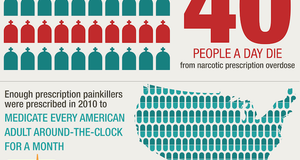Perpetuating the Cycle: Opioid Addiction and the Criminal Justice System
By
2016, Vol. 8 No. 07 | pg. 2/2 | « Treatment MethodsUnderstanding why people choose to use opiates and how the drug affects them is an important consideration in developing any plan to combat addiction. Emotions play a major role in a heroin addict’s life and many heroin addicts have been found to fall into similar categories of mental health. Studies have shown that many people who become heroin addicts suffer from high anxiety and depression prior to becoming addicted to heroin and that heroin usage quickly becomes their way of coping with negative emotions like sadness and anger (Blum et al., 2013). Heroin addicts also face a great deal of social stigma such as stereotyping, separation, and discrimination which then leads to an increase in anxiety and depression symptoms (Frischknecht, 2013). Those findings demonstrate that incarcerating heroin addicts means putting them in a place where they will be separated from society, and clearly incarceration is some form of discrimination even if it is justified. This in no way means that people should be free to break the laws of the country or face no ramifications for their illegal actions but understanding what incarceration does for the heroin dependent offender is crucial to solving the problem. There are options during incarceration involving treatment for heroin addict offenders. Australia and some countries in Western Europe provide treatment during incarceration aimed at reducing overdose deaths, the spread of HIV, and criminal recidivism (Mitchell et al., 2009). Knowing that the risk of drug usage remains during incarceration and the fact that there is a high rate of needle sharing in prison the World Health Organization recommends some form of opioid treatment in prisons especially because the sudden detoxification that can occur during incarceration can increase the risk of overdose death from the same dose the offender was using before incarceration (Mitchell et al., 2009). There are two primary kinds of treatment options for opioid addicts; one is called methadone maintenance treatment and the other is called heroin-assisted treatment (Blanken et al., 2012). Methadone maintenance treatment uses methadone or a drug called buprenorphine as a kind of replacement therapy for heroin addicts that is supposed to lessen opiate cravings. Heroin-assisted treatment involves a medical professional providing pharmaceutical grade heroin to addicts in a controlled way that allows for the offender to be slowly weaned off of the drug (Blanken et al., 2012). The benefits to both treatment types clearly involve preventing the addict from craving the drug; in methadone treatment the drug is replaced by methadone from which the addict could be weaned. The heroin-assisted treatment also prevents cravings and withdrawal by providing the safest form of heroin that has not been mixed or cut with any other substances on the street. The heroin-assisted method also allows a medical professional to control the dosage and slowly lower the amount until the addict no longer needs the drug.Because there is a high likelihood of people suffering from opiate withdrawal while incarcerated it would benefit the addict and society if the offender were to receive some type of treatment while incarcerated. Even though jails and prisons are not completely drug free they are certainly more controlled than out on the streets and provide a good opportunity for daily interaction between drug offender and treatment personnel. There is also a documented increase in the percentage of released inmates who continue to seek treatment if they received some form of treatment while incarcerated (Mitchell et al., 2009). Medical treatment for opiate addiction has proved to be very successful and there are several potential new treatments still being studied by researchers (Kuhn et al., 2014). It is possible to cure people of opiate addiction even though the road might be a long and difficult one. It is well-known that addiction is cognitive, emotional, and neurobiological (Blanken et al., 2012), so a criminal justice or treatment program that does not address all three areas of addiction will likely fail. There are some who believe that treatments like those involving methadone or even heroin in controlled pharmaceutical doses does nothing except exacerbate the problem by ignoring the social and psychological reasons for addiction and replacing one addiction for another in the case of methadone (Kuhn et al., 2014). This view does have merit because of the three pronged monster that addiction is known to be. Thus far this paper has shown how opiate addiction can be handled more effectively through drug courts and medical treatment but that leaves the emotional or social arm of addiction. Groups like Narcotics Anonymous can fill that void by being a place to go for fellowship with others who understand the problems that each other face. Narcotics Anonymous (2014) claims that their primary goal is to be a place of recovery and support. When considering whether or not treatments like methadone therapy merely replace one addiction for another it should be noted that methadone is viewed by addiction specialists as an effective treatment (Kuhn et al., 2014). Despite this belief there is a place for drugs like buprenorphine because it works differently than methadone in that it blocks the body’s opiate receptors from receiving other opiates and acting in a way that is just enough to keep withdrawal symptoms from appearing (Kuhn et al., 2014). Because it is different in its strength at the opiate receptors it might be a better solution as it does not create the same high as heroin and is therefore less likely to be abused. Buprenorphine is also different than methadone because it can be mixed with another drug called naloxone which prevents the user from getting high by injecting it rather than taking it in its pill form like it is designed (Kuhn et al., 2014). Discussion & ConclusionThe drug problem in the United States has fueled explosive growth in the prison populations and the war on drugs cannot be called a victory. The risks and consequences associated with drug use in general, and specifically with opiate use, include crime, violence, health risks, accidents, and economic consequences felt by all of society. There is no doubt that the problem of opiate addiction is one worthy of serious attention but the current system is failing to address the issues effectively and perhaps might even have played a role in the severity of the current opiate epidemic. The traditional way that the criminal justice system has treated drug offenders had a goal of drug crime cessation through deterrence and only had treatment as a secondary goal. It is possible, however, to treat opiate addiction effectively and the studies into the efficacy of drug courts have proven that. Drug courts are also a cost effective way to fight the opiate problem compared to typical incarceration costs. Providing drug treatment as a primary goal of drug court sentences will address all three areas of addiction when coupled with drug counseling such as that provided by Narcotics Anonymous. Although not certain, the prospects of drug courts and treatment options are promising and at this point any new and innovative strategy should be considered over the heavy prison sentences that appear to do nothing but perpetuate the opiate cycle of addiction. ReferencesBlanken, P., Hendriks, V., Koeter, M., van Ree, J., & van den Brink, W. (2012). Craving and illicit heroin use among patients in heroin-assisted treatment. Drug and Alcohol Dependence, 120(1-3), 74-80. DOI: 10.1016/j.drugalcdep.2011.06.025 Blom Nilsson, M., Lundgren, L., & Chassler, D. (2014). Predisposing, enabling, and need factors of heroin addicts’ using prescribed methadone or buprenorphine for a year or longer: An exploratory study of drug treatment for heroin addicts in the Swedish welfare system. Nordic Studies on Alcohol and Drugs, 31(2). DOI: 10.2478/nsad-2014-0014 Blum, J., Gerber, H., Gerhard, U., Schmid, O., Petitjean, S., Riecher-Rossler, A., Wiesbeck, G., Borgwardt, S., & Walter, M. (2013). Acute effects of heroin on emotions in heroin-dependent patients. American Journal of Addictions, 22(6), 598-604. DOI: 10.1111/j.1521-0391.2013.12025.x CBS Denver. (2015, May 20). Colorado’s ‘largest and most complex heroin bust’ nets 34 as use of the drug thrives. CBS News. Retrieved from http://denver.cbslocal.com/2015/05/20/colorados-largest-and-most-complex-heroin-bust-nets-34/ Cicero, T., Ellis, M., Surratt, H., & Kurtz, S. (2014). The changing face of heroin use in the United States: A retrospective analysis of the past 50 years. JAMA Psychiatry, 71(7), 821-826. DOI: 10.1001/jamapsychiatry.2014.366 Davidson, P., Ochoa, K., Hahn, J., Evans, J., & Moss, A. (2002). Witnessing heroin-related overdoses: The experiences of young injectors in San Francisco. Addiction, 97(12), 1511-1516. DOI: 10.1046/j.1360-0443.2002.00210.x Drug Enforcement Administration. (2015, November 4). Mexican drug traffickers remain most significant criminal drug threat to the United States. Retrieved from http://www.dea.gov/divisions/hq/2015/hq110415.shtml Frischknecht, U., Hermann, D., Heinrich, M., Hoerst, M., Weber-Fahr, W., Vollstadt-Klein, S., Kiefer, F., Mann, K., & Ende, G. (2013). Experience of social discrimination correlates with neurometabolism: A pilot study in heroin addicts. European Archives of Psychiatry and Clinical Neuroscience, 263(3), 197-203. DOI: 10.1007/s00406-012-0319-6 Gonzalez, B. (2016, February 5). Colorado drug related deaths increasing at “epidemic” proportions. ABC News. Retrieved from http://www.thedenverchannel.com/news/local-news/colorado-drug-related-deaths-increasing-at-epidemic-proportions/ Gordon, M., Kinlock, T., Schwartz, R., Couvillion, K., & O’Grady, K. (2013). The severity, frequency, and variety of crime in heroin-dependent prisoners enrolled in a buprenorphine clinical trial. The Prison Journal, 93(4), 390-410. DOI: 10.1177/003288551300753 Grogger, J., & Willis, M. (2000). The emergence of crack cocaine and the rise in urban crime rates. The Review of Economics and Statistics, 82(4), 519-529. DOI: 10.1162/003465300558957 Hayes, M., & Brown, M. (2012). Epidemic of prescription opiate abuse and neonatal abstinence. The Journal of the American Medical Association, 307(18), 1974-1975. DOI: 10.1001/jama.2012.4526 Henrichson, C., & Delaney, R. (2012). The price of prisons: What incarceration costs taxpayers. Federal Sentencing Reporter, 25(1), 68-80. DOI: 10.1525/fsr.2012.25.1.68. Hucklesby, A. (2010). Drug interventions in criminal justice. Maidenhead: Open University Press/McGraw-Hill Education. Kuhn, C., Swartzwelder, S., & Wilson, W. (2014). Buzzed: The straight facts about the most used and abused drugs from alcohol to ecstasy (4th ed.). New York, NY: W.W. Norton & Company. Mitchell, S., Kelly, S., Brown, B., Reisinger, H., & Peterson, J. (2009). Incarceration and opioid withdrawal: The experiences of methadone patients and out-of-treatment heroin users. Journal of Psychoactive Drugs, 41(2), 145-152. DOI: 10.1080/02791072.2009.10399907 Narcotics Anonymous. (2014). Information about NA. Retrieved from http://na.org/admin/include/spaw2/uploads/pdf/PR/Information_about_NA.pdf Saadatmand, Y., Toma, M., & Choquette, J. (2012). The war on drugs and crime rates. Journal of Business & Economics, 10(5), 285-290. Sevigny, E., Pollack, H., & Reuter, P. (2013). Can drug courts help to reduce prison and jail populations? The ANNALS of the American Academy of Political and Social Science, 647(1), 190-212. Strang, J., Gossop, M., Heuston, J., Green, J., Whiteley, C., & Maden, A. (2006). Persistence of drug use during imprisonment: Relationship of drug type, recency of use, and severity of dependence to use of heroin, cocaine, and amphetamine in prison. Addiction, 101(8), 1125-1133. DOI: 10.111/j.1360-0443.2006.01475.x Waterman, C. (2015, July 27). ‘I’ve literally ruined my life’: Bay City heroin addict shares his story amid overdose epidemic. Michigan Live. Retrieved from http://www.mlive.com/news/bay-city/index.ssf/2015/07/bay_city_heroin_addict_shares.html Suggested Reading from Inquiries Journal
Inquiries Journal provides undergraduate and graduate students around the world a platform for the wide dissemination of academic work over a range of core disciplines. Representing the work of students from hundreds of institutions around the globe, Inquiries Journal's large database of academic articles is completely free. Learn more | Blog | Submit Latest in Criminology & Criminal Justice |
















